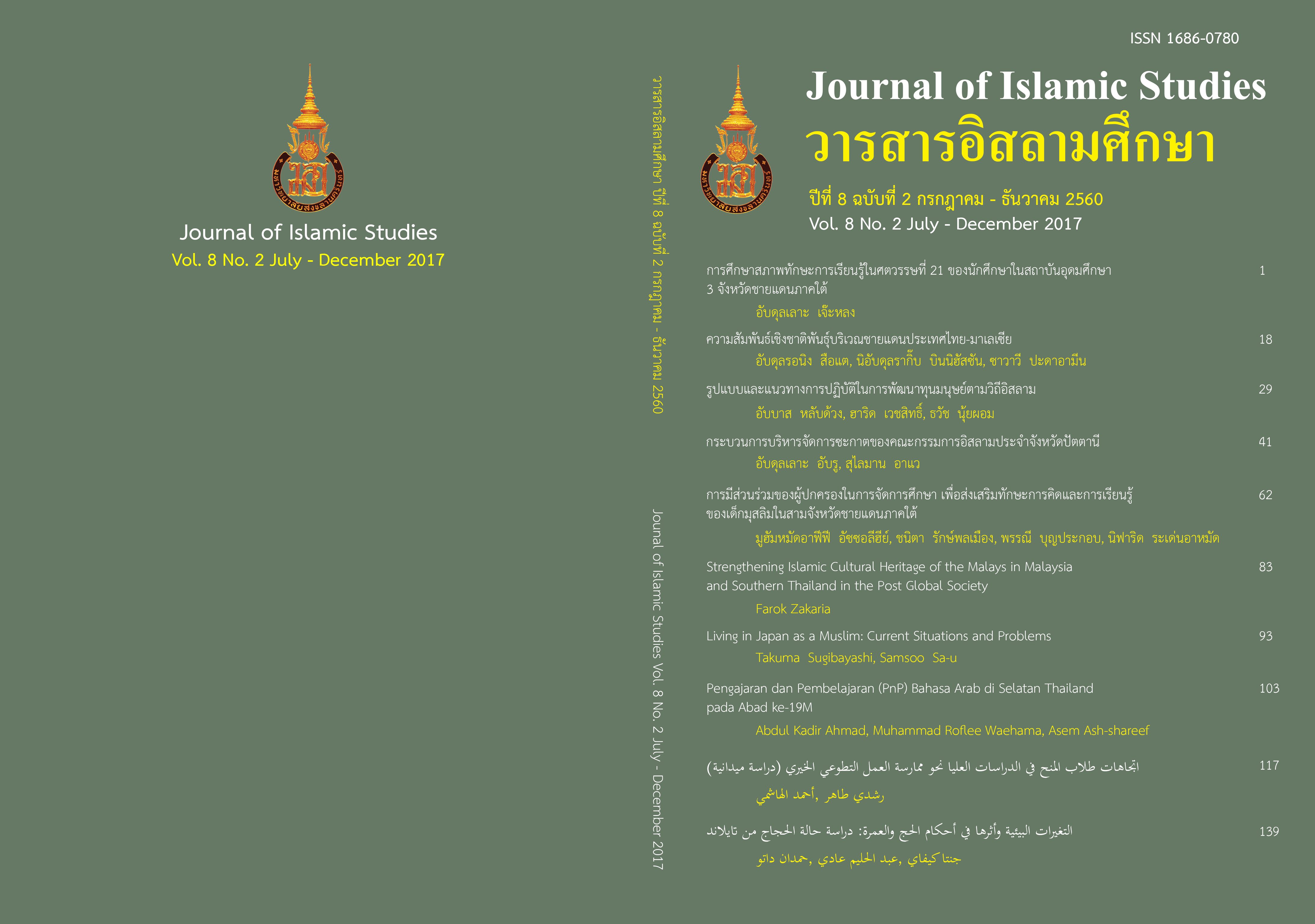รูปแบบและแนวทางการปฏิบัติในการพัฒนาทุนมนุษย์ตามวิถีอิสลาม
บทคัดย่อ
บทความนี้มีวัตถุประสงค์เพื่อศึกษารูปแบบและแนวทางการปฏิบัติในการพัฒนาทุนมนุษย์ตามวิถีอิสลาม เป็นการวิจัยเอกสาร (Documentary Research) โดยใช้ข้อมูลทุติยภูมิ (Secondary Data) จากการศึกษาค้นคว้าเอกสารและงานวิจัยที่เกี่ยวข้อง โดยรวบรวมทบทวนและวิเคราะห์ เพื่อให้ได้รูปแบบและแนวทางการปฏิบัติในการพัฒนาทุนมนุษย์ตามวิถีอิสลาม ผลการศึกษาพบว่าทฤษฎีทุนมนุษย์ทั่วไปมีเป้าหมายเพื่อให้บรรลุการเติบโตทางเศรษฐกิจ ส่วนทฤษฎีทุนมนุษย์ตามหลักการอิสลามมีเป้าหมายเพื่อให้บรรลุถึงคุณภาพและมนุษย์นั้นเพื่อเป็นตัวแทนของอัลลอฮฺบนหน้าแผ่นดิน การพัฒนาทุนมนุษย์ในองค์กรต้องมีการพัฒนาทุนมนุษย์ให้สอดคล้องกับกลยุทธ์เป้าหมาย วิสัยทัศน์ หรือสอดคล้องกับการสร้างสมรรถนะความสามารถ (Competency) ของคนในองค์กร การพัฒนาทุนมนุษย์ตามวิถีอิสลาม นั้นต้องครอบคลุมในด้านต่าง ๆ อาทิเช่น การพัฒนาด้านจิตวิญญาณ ด้านกายภาพและร่างกาย ด้านความรู้และสติปัญญา และด้านคุณธรรม และจริยธรรม เป็นต้น โดยส่วนหนึ่งของรูปแบบและแนวทางการปฏิบัติในการพัฒนาทุนมนุษย์ตามวิถีอิสลาม มีดังนี้ (1) สร้างความเป็นหนึ่งเดียว (ญามาอะฮฺ) (2) การปรึกษาหารือ (3) การตักเตือนซึ่งกันและกัน (4) การสร้างความรัก (5) การให้เกียรติและปฏิบัติต่อกันด้วยดี
เอกสารอ้างอิง
ประไพทิพย์ ลือพงษ์. มปป. การพัฒนาทุนมนุษย์ให้มีสมรรถนะความสามารถในการแข่งขัน. มหาวิทยาลัยรามคำแหง
พจนานุกรม ฉบับราชบัณฑิตยสถาน พ.ศ. 2542. (2546).กรุงเทพฯ: ศิริวัฒนาอินเตอร์พริ้นท์.
มูฮำหมัด อีแมดือเระ. (2558). ความสัมพันธ์ระหว่างการจัดการทรัพยากรมนุษย์ในอิสลามต่อประสิทธิภาพการทำงานของเจ้าหน้าที่สหกรณ์อิสลาม อิบนูอัฟฟาน จำกัด. ปัตตานี: วิทยานิพนธ์ศิลปศาสตรมหาบัณฑิต สาขาอิสลามศึกษา. มหาวิทยาลัยสงขลานครินทร์.
สมาคมนักเรียนเก่าอาหรับ ประเทศไทย. (2542). พระมหาคัมภีร์อัลกุรอานพร้อมความหมายภาษาไทย. อัลมะดีนะฮฺอัลมุเนาวะเราะฮฺ: ศูนย์กษัตริย์ฟาฮัด เพื่อการพิมพ์อัลกุรอาน.
อับดุลเลาะ อับรู. (2555). ระบบเศรษฐกิจอิสลาม: ทางเลือกเพื่อสังคมเศรษฐกิจที่สมดุล. ปัตตานี: อิสลามกับความท้าทายของโลกสมัยใหม่: มุมมองจากนักวิชาการชายแดนใต้. สำนักงานกองทุนสนับสนุนการสร้างเสริมสุขภาพ.
Abduhu, J.M. (1984), Dawru al-Manhaj al-Islami fi Tanmiyyati al-Mawarid al-Bashariyyah,
Mu’ssasah al-Risalah, Amman.
Bateman, S. T., & Snell, A. S. (2009).Management: Leading &Collaborating in a competitive World (8th ed.).Boston: McGraw Hill
International Islamic Jurisprudence Academy (2007), available at: www.fiqhacademy.org.sa/
Malaysia-q18.pdf (accessed 7 August 2010).
Md. Faruk Abdullah., (2012). "The role of Islam in human capital development: a juristic analysis", Humanomics, Vol. 28 Issue: 1, pp.64-75,
Njegovan, Z. (2006), “Local strategic planning as a factor of regional development in the republicof Serbia”, paper presented at the 46th Congress of the European Regional ScienceAssociation, University of Thessaly, Volos
Seyed Kazem Sadr, (2015),. "The role of human capital in economic development of the earliest Islamic period", International Journal of Islamic and Middle Eastern Finance and Management, Vol. 8 Issue: 4, pp.398-417, https://doi.org/10.1108/IMEFM-12-2014-0122
Siddiqi, M.I. (1984). The Family Laws of Islam, Kazi Publications, Lahore.
ดาวน์โหลด
เผยแพร่แล้ว
รูปแบบการอ้างอิง
ฉบับ
ประเภทบทความ
สัญญาอนุญาต
บทความทุกเรื่อง ที่ได้รับการตีพิมพ์ในวารสารอิสลามศึกษาเป็นแนวคิดของผู้เขียน มิใช่เป็นความคิดเห็นคณะผู้จัดทำและมิใช่ความรับผิดชอบของคณะวิทยาการอิสลาม กองบรรณาธิการไม่สงวนสิทธิ์การคัดลอก แต่ให้มีการอ้างอิงแสดงที่มา




